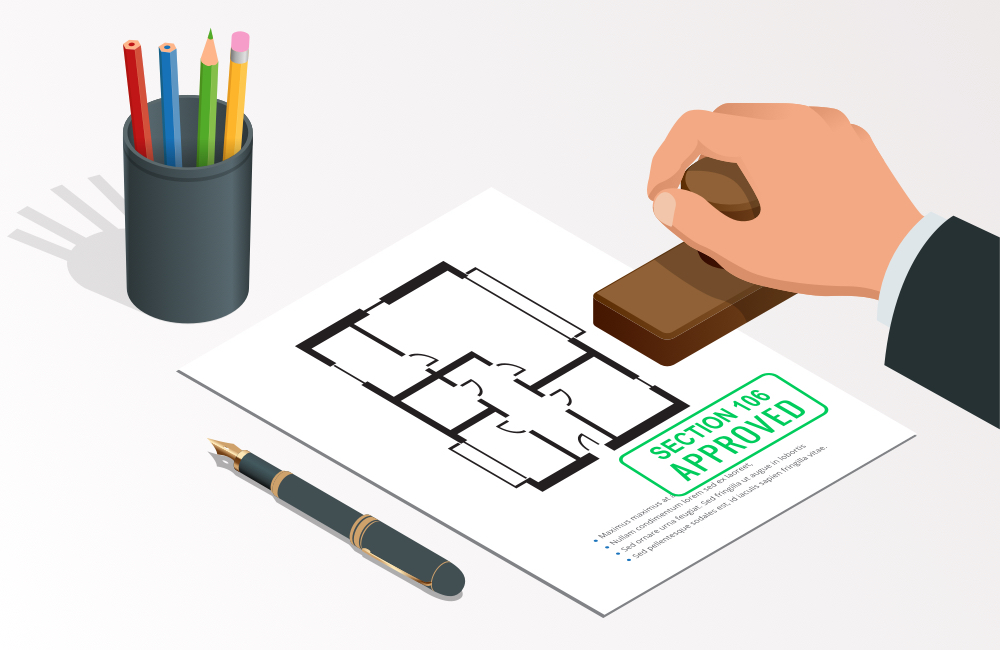
TheHouseShop and The Accessible Property Register and are fully compliant for builders and Property Developers who need to comply with section 106 of the planning legislation.
What Is Section 106?
Section 106 (S106) agreements are linked to planning permissions and are also be known as planning obligations. They are legal agreements between local authorities and developers.
Section 106 agreements are drafted when it is considered that a development will have significant impacts on the local area that cannot be moderated by means of conditions attached to a planning decision.
For more information on how to advertise in compliance with Section 106 on TheHouseShop and The Accessible Property Register, see our Accessible Property Page.
What are planning requirements under Section 106?
Section 106 agreements, or planning obligations, are based on that section of the 1990 town & country planning act. They are private agreements made between local authorities and developers and can be attached to planning permission to make acceptable development that would otherwise be unacceptable in planning …
For example, new residential development can place extra pressure on the social, physical and economic infrastructure which already exists in a certain area.
Section 106 Agreements are becoming increasingly complex. The requirements imposed by the Community Infrastructure Levy Regulations (CIL) conspire to produce a regulatory minefield for the unwary, particularly when a local planning authority seeks to use a tariff-based approach to justify contributions. We have extensive experience in advertising your accessible units to comply with Section 106 Obligations and will minimise the burden of obligations on the advertising of the development.

London councils and new property developments
Southwark Council Wheelchair Accessible Housing
In line with the London plan (2015) and saved the Southwark plan policy, a minimum of 10% of all new housing must be wheelchair accessible. In exceptional circumstances, and where it can be shown that this is not achievable, we will seek a section 106 planning obligation from the developer to contribute towards the adaptation of other homes
in the borough to meet the needs of people with a range of disabilities. See report
Lewisham council accessible housing planning
The council will expect a minimum of 10% of all housing, including affordable housing, to be adapted or easily adaptable to the south-east London housing partnership wheelchair homes design guidelines (November 2012) Or Any successor version of this document. A copy of the southeast London housing Partnership Wheelchair Homes Design Guidelines (SELHP Guidelines) can be found on the council’s website (Www.lewisham.gov.uk).
The council will secure the timely provision, and retention in perpetuity, of wheelchair units (both affordable and private), provided as part of development through a planning obligation (or condition where appropriate). This will include fit-out requirements for affordable units and details of the developer’s marketing responsibilities for both affordable and private units. Where wheelchair units are not provided (or cannot be provided to the required standard) the council will seek a financial contribution towards the provision of wheelchair housing elsewhere in the
borough. See report
Developers and property builders
Our website and its community help builders, property developers and housing associations comply with 106 planning agreements. We promote wheelchair adapted homes suitable for disabled people and help builders access a highly targeted and engaged audience.
Wheelchair Housing
Many Londoners require accessible housing to lead independent and dignified lives. Lifetime homes are suitable for most occupiers but are not a substitute for purpose-designed wheelchair standard housing. Wheelchair users require purpose-designed wheelchair housing and would find a lifetime homes standard dwelling inadequate for their space requirements. Wheelchair housing is designed to specifically meet the diverse and changing needs of wheelchair users and the multiplicity of impairments that some wheelchair users experience. Greater spatial demands and increased flexibility and specification in a property designed to wheelchair housing standards aim to ensure that not only does a wheelchair user have access to every facility inside and outside of the dwelling, but also has a choice on how best to approach (and sometimes adjust) that facility to suit their particular needs.
Increase In Accessible Housing Planned
According to the research, despite 13.9million disabled people in the UK and a rapidly ageing population, only seven per cent of English homes currently provide even the most basic accessibility features.
“Too many people are today living in homes that limit their independence, as we face a dangerous shortage of homes that are accessible and adaptable,” commented Anna Dixon, chief executive at the centre for ageing better, which co-chairs the coalition.
“Whilst it’s not inevitable, the likelihood is that most of us will experience disability or difficulties with activities of daily living at some point in our later life. And with more of us living for longer, this dire lack of accessible homes represents a ticking timebomb.”
By 2030, projected figures suggest that there will be just one new accessible home built for every 15 people over the age of 65. Go to source this.co.uk




 POSTED BY
POSTED BY 

